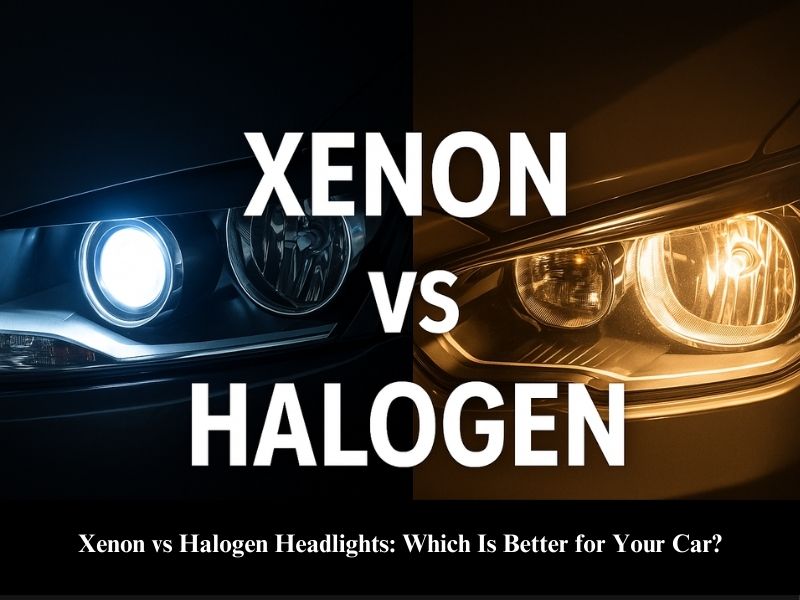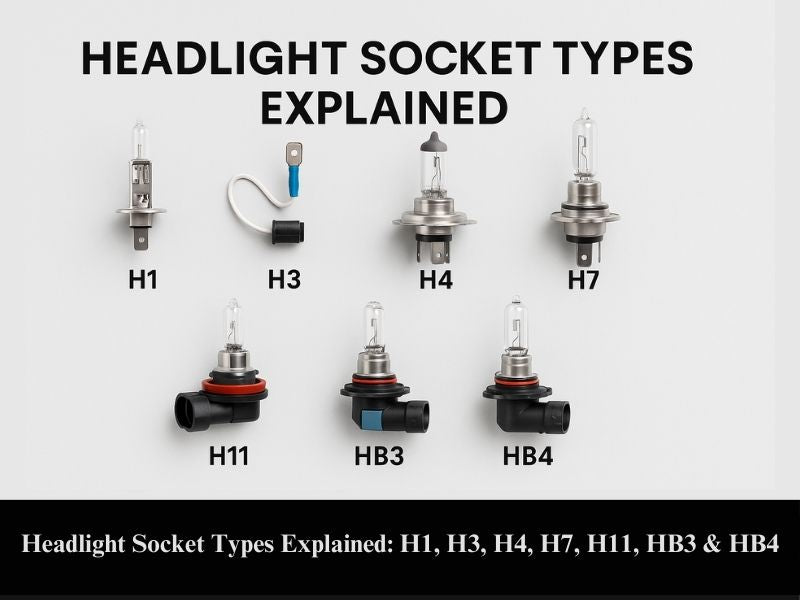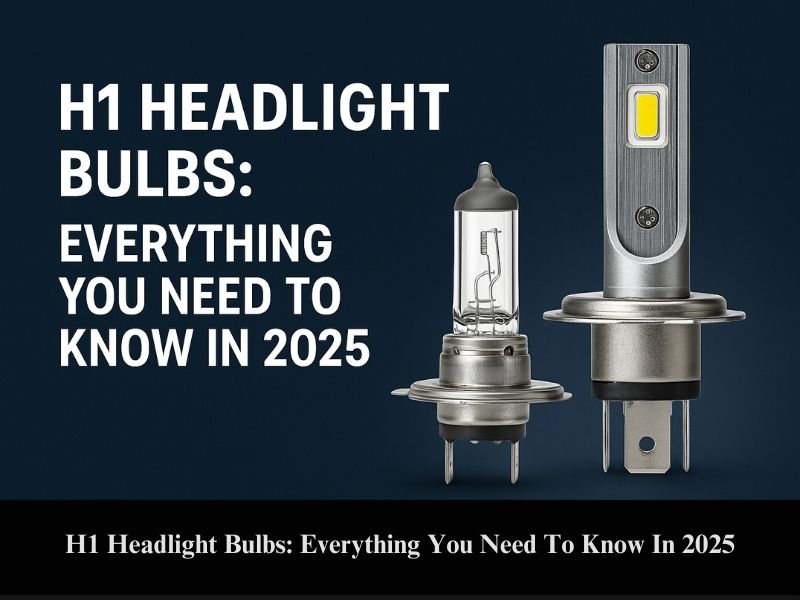Choosing the right tail lights and brake lights for your car is essential for both safety and style. With so many options available, it can be overwhelming to know where to start.
In this article, we’ll guide you through the process, offering tips on what to look for, how to choose the best lights for your vehicle, and why the right selection can improve visibility and enhance the overall appearance of your car.
So, without further ado, let’s read on our article and make an informed decision that’s perfect for your needs!
What Are Tail Lights?
Tail lights are essential components of a vehicle's lighting system, typically located at the rear. Their primary function is to signal the presence of the vehicle to other drivers, particularly in low-light conditions or at night. Tail lights are usually activated whenever the vehicle’s headlights are on.
Basic Roles of Tail Lights:
-
Visibility: Tail lights help other drivers see your vehicle, preventing accidents, especially in dim lighting or during nighttime driving.
-
Signal Presence: They alert other road users to the vehicle's position on the road, making it easier for drivers to judge distances.
-
Red Color: The red color of tail lights is standardized for rear visibility, ensuring consistency and reducing confusion.
In short, tail lights are about visibility and safety. They make sure your vehicle is clearly visible to others while driving, especially when there's limited visibility.
What Are Brake Lights?
Brake lights, found at the rear of the car as well, are critical for indicating when a driver is slowing down or stopping. They activate when the brake pedal is pressed, signaling to vehicles behind that the car is slowing or coming to a halt. Brake lights are usually brighter and more noticeable than tail lights, ensuring that the intention to stop or slow down is clearly communicated.
Basic Roles of Brake Lights:
-
Indicate Braking: Brake lights signal to drivers behind you that you are stopping or slowing down, providing them with critical reaction time.
-
Safety Feature: The primary function is to prevent rear-end collisions by alerting others in time for them to react.
-
Bright Visibility: Brake lights are brighter than tail lights to ensure their effectiveness in alerting other drivers.
In essence, brake lights are designed to keep you safe by giving other road users a clear warning whenever you intend to stop.
Key Differences Between Tail Lights and Brake Lights
While tail lights and brake lights may seem similar, they serve distinct roles in vehicle safety. Here’s a breakdown of the key differences:
|
Feature |
Tail Lights |
Brake Lights |
|
Purpose |
To signal a vehicle’s presence to others, especially in low visibility conditions. |
To alert other drivers when the vehicle is stopping or slowing down. |
|
Activation |
Automatically when headlights are on. |
Activated when the brake pedal is pressed. |
|
Brightness |
Dimmer, providing a constant signal. |
Brighter, ensuring visibility during braking. |
|
Color |
Red (standard for visibility). |
Red or sometimes orange, but brighter and more intense. |
|
Visibility Range |
Primarily for night driving or poor weather conditions. |
Provides more noticeable alert to surrounding drivers. |
To sum up, while both tail lights and brake lights are crucial for vehicle safety, they serve different yet complementary functions.
-
Tail lights are primarily focused on visibility, ensuring that your vehicle is seen by others in low-light conditions
-
On the other hand, brake lights are designed to alert drivers behind you that you're slowing down or stopping.
As you can see, having a good understanding of these differences can help ensure you're using your vehicle’s lighting system effectively for maximum safety on the road.
Why Tail Lights and Brake Lights Matter for Your Car
Tail lights and brake lights play a vital role in ensuring both safety and visibility on the road. Without these lights functioning properly, drivers are at a much higher risk of accidents, especially in conditions where visibility is compromised, such as at night, in fog, or during rainy weather.
Importance for Safety and Visibility
-
Preventing Rear-End Collisions: Brake lights, in particular, are crucial in warning drivers behind you that your car is stopping or slowing down. This gives them time to react and avoid a potential rear-end collision.
-
Clear Communication: Tail lights make your vehicle visible to others from a distance, signaling your presence even when you're not actively braking. This is particularly important in low-light conditions where other vehicles might have trouble spotting you.
-
Awareness in Bad Weather: In adverse weather conditions like fog, rain, or snow, visibility is significantly reduced. Functional tail lights and brake lights help ensure your car is seen, reducing the risk of accidents in these challenging conditions.
When your lights are working correctly, it contributes to better communication between you and other road users, improving overall road safety.
Legal Requirements and Regulations
In many regions, there are strict laws surrounding the use of tail lights and brake lights. These regulations ensure that vehicles are equipped with the necessary lighting systems to maintain road safety. Failure to comply with these requirements can result in fines or even your vehicle being deemed unroadworthy.
-
Tail Lights: Most jurisdictions require that vehicles have red tail lights, which must be visible from a certain distance (typically 500-1000 feet). They must also remain illuminated when the vehicle’s headlights are on.
-
Brake Lights: Regulations generally state that brake lights must be bright enough to be easily seen from behind, and they must activate when the brake pedal is pressed. In some places, there are even requirements for a specific number of brake lights, ensuring the rear of the car is adequately lit up.
In summary, both for safety and legal compliance, it's crucial to ensure your tail and brake lights are functioning properly at all times. These lights are not only necessary to avoid accidents but also a requirement for roadworthy vehicles.
Types of Tail Lights and Brake Lights
When selecting the right tail and brake lights for your car, it’s important to understand the different types available. Each type has its own set of features, advantages, and drawbacks. Here’s an overview of the most common types of tail and brake lights you’ll find in vehicles:
1. Incandescent Tail and Brake Lights
Incandescent bulbs are the traditional type of lighting used in vehicles. They work by heating a filament inside the bulb, which then emits light.
Advantages:
-
Widely available and relatively inexpensive.
-
Simple design and easy to replace.
Disadvantages:
-
Less energy-efficient compared to newer lighting technologies.
-
Shorter lifespan, meaning they need to be replaced more frequently.
-
Not as bright as modern alternatives, which can affect visibility, especially at night.
Incandescent bulbs are still used in many older vehicles and are often the most affordable option.
2. Halogen Tail and Brake Lights
Halogen bulbs are a type of incandescent bulb that contains halogen gas, which helps to improve brightness and lifespan.
Advantages:
-
Brighter than standard incandescent bulbs, providing better visibility.
-
Longer lifespan than traditional incandescent bulbs.
-
Still relatively affordable compared to newer technologies.
Disadvantages:
-
Less energy-efficient than LED lights.
-
Can get very hot, which may impact the bulb’s lifespan and performance.
-
Larger size compared to LED alternatives, potentially requiring more space.
Halogen lights are commonly found in vehicles and offer a balance between brightness and cost.
3. LED Tail and Brake Lights
Light Emitting Diodes (LED) are one of the most advanced types of lighting for cars, offering significant improvements in efficiency and performance.
Advantages:
-
Extremely energy-efficient, using less power and extending battery life.
-
Long lifespan, often lasting tens of thousands of hours.
-
Brighter and more visible, providing superior safety, especially in poor weather conditions.
-
Durable and resistant to shock, which makes them more reliable in harsh conditions.
Disadvantages:
-
Higher upfront cost compared to incandescent or halogen bulbs.
-
Some may require specific wiring or installation expertise.
LED lights are increasingly the standard in newer vehicles due to their energy efficiency, brightness, and long-term cost-effectiveness.
4. High-Mounted Brake Lights (Third Brake Light)
The high-mounted brake light, often referred to as the third brake light, is positioned above the rear windshield of a vehicle, typically in the center. This light is specifically designed to provide an additional warning to drivers behind the car.
Advantages:
-
Improves visibility for vehicles behind you, particularly in situations where the lower brake lights may be obstructed (such as in heavy traffic or when the vehicle is loaded).
-
Can reduce the risk of rear-end collisions by providing an additional brake signal.
-
Commonly found as a standard feature in modern vehicles.
Disadvantages:
Generally, third brake lights are smaller and less noticeable than the primary brake lights, which can limit their effectiveness in certain situations.
High-mounted brake lights are a critical safety feature that can make a noticeable difference in preventing accidents.
Is It Worth Upgrading to LED Headlights for Your Car’s Tail Lights and Brake Lights?
Yes, it’s definitely worth it. If your car still uses traditional halogen or incandescent bulbs, switching to LED tail lights and LED brake lights can be a smart upgrade. Here’s why:
-
Better Visibility – LED lights are brighter and more noticeable, which helps other drivers see your vehicle more clearly, especially in poor weather or at night.
-
Energy Efficiency – LEDs consume less power, which can reduce strain on your vehicle’s electrical system and battery.
-
Modern Look – Upgrading to LED lights gives your car a cleaner, more updated appearance.
-
Longer Lifespan – LEDs typically last much longer than halogen bulbs, meaning fewer replacements over time.
While LED lights may cost more upfront, they often pay off in the long run by improving safety, saving energy, and reducing maintenance.
Are There Aftermarket LED Options for Tail Lights and Brake Lights?
Yes, many aftermarket LED kits are available for a wide range of car makes and models. Whether you're upgrading for better performance, improved style, or added safety, there are plenty of choices on the market.
Popular brands like Morimoto, Sealight, Auxbeam, and Carifex offer LED tail light and brake light kits that come in various styles, brightness levels, and features.
Here are a few things to keep in mind when choosing aftermarket LED lights for your car:
-
Compatibility: Always check that the LED kit is compatible with your car’s make, model, and year.
-
Certifications: Choose lights that are DOT or ECE certified to ensure they meet legal safety standards.
-
Trusted Brands: Go with reputable manufacturers known for quality and positive customer reviews.
In short, upgrading to aftermarket LED tail and brake lights is a great way to boost your car’s safety, efficiency, and appearance, no matter what type of vehicle you drive.
How to Choose the Right LED Tail Lights and Brake Lights for Your Car?
Upgrading to LED tail and brake lights is a smart move, but choosing the right ones for your vehicle takes a bit of planning. Here's a straightforward guide to help you make the right choice:
1. Check Compatibility with Your Vehicle
-
Confirm the LED lights are compatible with your car’s make, model, and year.
-
Use your vehicle’s owner’s manual or an online fitment guide to find the correct bulb size or housing type.
-
Make sure the lights will fit without needing major modifications.
2. Look for Certified and Road-Legal Products
-
Choose LED lights that meet DOT (Department of Transportation) or ECE (Economic Commission for Europe) standards.
-
Certified products ensure the lights are safe, legal, and reliable for road use.
3. Choose the Right Brightness Level
-
Go for LEDs that are bright enough to be seen clearly, but not so bright that they dazzle other drivers.
-
Many quality LED lights come with lumens rating—look for balanced options that offer visibility without glare.
4. Evaluate the Build Quality
-
Select lights made with durable materials like polycarbonate lenses and aluminum housings.
-
Ensure the product is waterproof and dust-resistant (IP65 or higher) for long-term performance in all conditions.
5. Consider Plug-and-Play Installation
-
Many LED kits offer plug-and-play designs, which makes installation easier without rewiring.
-
Double-check if resistors or decoders are needed to prevent flickering or dashboard errors.
6. Think About Style and Appearance
-
LED tail and brake lights come in different styles like clear, smoked, or red lenses.
-
Pick a design that matches your car’s look while staying functional and visible.
7. Stick with Trusted Brands
-
Reputable brands often deliver better performance, longer life, and warranty support.
-
Examples include: Morimoto, Sealight, Auxbeam, Philips, and Carifex.
Choosing the right LED lights means balancing functionality, style, safety, and legality. Take your time to research and go with a quality option that will serve you well on the road.
Where to Buy the Best LED Tail Light and Brake Light Bulbs For My Car in 2025
Ready to enhance your car's headlights with high-performance LED bulbs? At Carifex, we provide a comprehensive selection of the latest LED lighting solutions tailored for a variety of vehicles, including LED Headlights, LED Tail Lights, LED Fog Lights, and many more.
Here’s why Carifex is your top choice for LED headlight bulbs:
-
Quality Assurance: Our LED bulbs adhere to rigorous quality standards, ensuring dependable and long-lasting performance whether you're on the highway or navigating off-road terrain.
-
Wide Selection: We offer a diverse range of designs and styles to complement your vehicle's aesthetics while fulfilling your lighting needs.
-
Competitive Pricing: Benefit from great value with our affordable pricing, making it easy to upgrade your vehicle’s lighting system without breaking the bank.
-
Customer Satisfaction: Our dedicated team is committed to providing outstanding customer service, helping you choose the ideal product and offering support with installation.
Explore our range of headlights and other LED automotive products today. Click below to visit our store and discover the perfect upgrades for your vehicle!
Related Article
-
6 Reasons Your Tail Lights Are Not Working, But Brake Lights Are
-
How To Choose the Right Aftermarket Car Tail Lights: Guide For 2024
Installation and Replacement Tips
Replacing your car’s tail lights and brake lights is a task many vehicle owners can handle with basic tools and a bit of care. Here are the general steps:
-
Turn off the car and disconnect the battery – This prevents electrical shorts or accidental shocks.
-
Access the tail light housing – Usually done by removing a panel in the trunk or unscrewing the housing from the rear of the vehicle.
-
Remove the old bulb – Gently twist and pull the bulb out of the socket.
-
Insert the new bulb – Ensure it's the correct type and fits securely in the socket.
-
Test the new light – Before reassembling, reconnect the battery and make sure the light works properly.
-
Reassemble the housing – Replace any panels or screws that were removed during the process.
Tip: Always wear gloves when handling new bulbs, especially halogens, to avoid oil transfer that can reduce bulb life.
Common Problems and Troubleshooting
Even with proper installation, tail lights and brake lights can sometimes fail. Here’s how to identify issues and know when it's time to get professional help:
Signs Your Tail or Brake Lights May Be Faulty:
-
Lights are not turning on at all.
-
Dim or flickering lights, even after bulb replacement.
-
Brake lights stay on continuously, even when you're not pressing the brake.
-
A warning light appears on your dashboard.
-
Other drivers honk or flash lights at you, indicating poor visibility from the rear.
How to Check for Common Issues:
-
Inspect the bulbs – Check if the filament is burnt or the LED is non-functional.
-
Test the fuses – Use a fuse tester or multimeter to check the tail/brake light fuse.
-
Examine the wiring – Look for signs of fraying, corrosion, or loose connections.
-
Check the brake light switch – If brake lights don’t turn on, this switch could be faulty.
When to Seek Professional Help:
-
Electrical issues like short circuits or burnt wiring.
-
Brake light malfunctions related to ABS systems or sensors.
-
Ongoing problems even after replacing bulbs and fuses.
If you’re unsure or uncomfortable with handling electrical components, it’s always safer to have a qualified mechanic look into the problem.
Final Thoughts
When choosing the best tail lights and brake lights for your vehicle, it’s important to consider their distinct roles in ensuring safety and visibility. Tail lights help other drivers spot your vehicle, especially in low-light conditions, while brake lights signal your intention to stop or slow down, offering critical time for others to react. Both lights are integral in preventing accidents, particularly in challenging weather conditions, and maintaining compliance with legal standards.
Upgrading to LED lights offers several benefits, such as improved brightness, energy efficiency, and longer lifespan, making them a wise investment for enhanced safety and reduced maintenance. Whether you opt for incandescent, halogen, or LED lights, choosing the right type for your car ensures that you meet safety regulations and enjoy optimal performance.
With the variety of aftermarket options available, it's crucial to select products that are compatible, certified, and reliable to ensure both style and functionality. Regular maintenance and prompt troubleshooting of any issues will further ensure that your vehicle’s lighting system remains effective and roadworthy.
Key Takeaways
-
Tail Lights are essential for vehicle visibility, particularly in low-light conditions, helping other drivers see your vehicle and judge distances accurately.
-
Brake Lights are designed to alert other drivers that your vehicle is slowing down or stopping, providing critical reaction time to prevent rear-end collisions.
-
Tail Lights vs. Brake Lights: While both are red, tail lights are dimmer and signal your vehicle's presence, while brake lights are brighter and indicate a reduction in speed.
-
Legal Requirements: Both tail and brake lights are subject to legal regulations in most regions, ensuring that they meet certain brightness and visibility standards to maintain road safety.
-
Lighting Technologies: Tail and brake lights come in various types, including incandescent, halogen, and LED, each with different advantages in terms of brightness, lifespan, and energy efficiency.
-
LED Lights are the best option for upgrading due to their brightness, energy efficiency, durability, and longer lifespan, despite a higher initial cost.
-
Aftermarket LED Options are available for upgrading your vehicle’s lights, with popular brands offering a wide range of styles, brightness levels, and features.
-
Importance of Compatibility: Always ensure that any replacement or upgraded lights are compatible with your car's make, model, and year to avoid installation issues.
-
Visibility and Safety: Both tail and brake lights play crucial roles in preventing accidents, improving visibility in poor weather conditions, and reducing rear-end collisions.
-
Maintenance and Troubleshooting: Regularly check your tail and brake lights for issues like dimness, flickering, or malfunctioning to ensure your vehicle’s safety and avoid legal fines.
FAQs
Can tail lights and brake lights use the same bulb?
Yes, many vehicles use a dual-filament bulb where one filament serves as the tail light and the brighter filament acts as the brake light. Some models have separate bulbs.
Why do brake lights appear brighter than tail lights?
Brake lights use higher-intensity illumination to alert drivers behind you, while tail lights emit a subtler glow for visibility without glare.
Are there legal requirements for tail lights and brake lights?
Yes, most regions mandate functional tail and brake lights to meet safety standards for roadworthiness.
Can I use LED lights for both tail lights and brake lights?
Yes, LEDs are energy-efficient and widely used for both functions in modern vehicles due to their brightness and durability.
Do vehicles have additional rear lights besides tail and brake lights?
Some vehicles include rear fog lights for enhanced visibility in heavy rain or fog.




